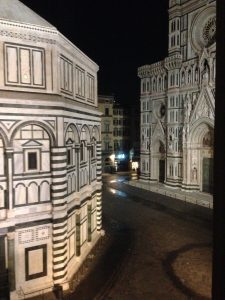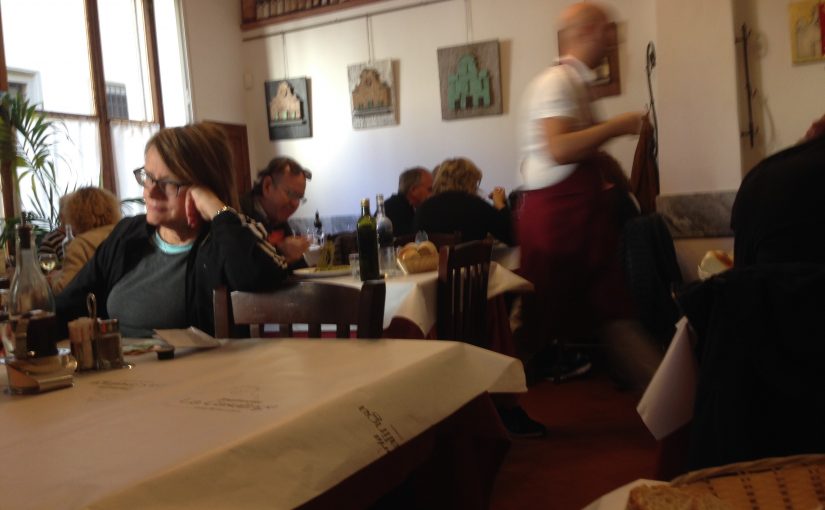It was mid-afternoon on Monday when I decided to take a trip to Firenze. I had run out of gigabytes, so I went to Blue Bar to use their wifi to check train schedules and find lodging. The idea of leaving Orvieto terrified me, but I needed to. Sunday morning’s quake rattled more than dishes, and I couldn’t find my balance. I felt that a trip might help. Plus, I’d promised Maria Teresa I’d visit in November, and on Tuesday it became November.
Maria Teresa runs an agriturismo called Casalini with her son and daughter-in-law in the tiny village of La Romola, eleven kilometers southwest of Firenze. She immediately replied to my request for a room. It’s olive harvest and they don’t take guests during olive harvest, she explained, but an exception will be made for a friend. Because I’d be arriving in Firenze too late for a bus to La Romola, I took the cheapest room I could find in centro storico, tucked as little as possible into my small backpack, and was on the 6:30 train to Stazione Santa Maria Novella.
The pensione where I booked a room phoned while I was waiting for the funicular to take me to Orvieto station. “We are a small place,” the woman explained in beautiful English, “so when do you expect to be here?” I couldn’t recall an exact time, so I told her around eight. “Then call a half hour before you arrive so we can make sure the room is prepared.” I called as soon as I got my ticket and knew the arrival time, also to ask for directions. The booking website didn’t list an address, only that it was “in centro.” She described their location as being “just off Piazza del Duomo.”
By the time I stood in Piazza del Duomo a couple of hours later, I’d forgotten if I was to face the Duomo or the Battistero to orient myself, and the clock snuck past my announced arrival time while I looked around in confusion. She called to see where I was. “Look up,” she said, after pointing me in the right direction, “See the crazy lady waving from the top floor window?” She buzzed me in, and I climbed four flights to Soggiorno Battistero. “There’s an elevator, why didn’t you take the elevator?” Because I enjoy climbing stairs? “Okay, but next time take the elevator, it’s not dangerous.” The room was small, very comfortable, and the view from its only window was of the heart of the Italian Renaissance (see photo.)
I stashed my stuff and hit the streets. It was after nine by then, day tourists had left, and the crowds seemed mostly local. There were witches and demons of all ages prowling the piazzas, whether by tradition or as an adaptation of the American holiday, I don’t know. A mood of festivity prevailed, and there was the joy of pretending to be someone a little weird. Not all of us have to wear costumes to do that.
Oh, but the light! Street lighting has improved since the 1970’s. All of centro storico is now illuminated like a stage set, but tastefully so, nothing self-conscious or strained, just good lighting that takes full advantage of the surrounding darkness. The yellow lamps from the 70’s are mostly gone, replaced by ones that mimic daylight. The effect is gorgeous beyond description.
And the glory restored! In 1975, Firenze looked a bit like the rundown capital of a developing country. As much of Orvieto is today, plaster was cracked and crumbled, stone gouged or missing, the streets uneven and littered. Now plaster is smooth and fresh in color, stone crisply restored, streets clean and in good repair. The city is wealthy again, and displays all the gorgeous detail that wealth can afford.
And the fresh night air! All my visits of the past twenty years have been in summer, mostly between the hours of 10 am and 10 pm when the city is flooded with tourists, and sweltering. The final night in October is a wholly different experience. I walked for hours in comfort, turning onto streets shared by only by two or three others. Most of them seemed equally enthralled, even the locals.
Tuesday, I woke shortly after five, opened the shutters, and was greeted by a view of an utterly empty Piazza del Duomo. I showered as quickly as was safe and was on the street by six. Two hours to breakfast, I was going to enjoy the magic.
There were only two of us in the breakfast room, and I sat next to her at another table so as not to force conversation. After a few minutes of this nonsense, I asked if she spoke English. She was from Tennessee, in Firenze with her husband for a week. They were in the middle of a seven week, self-guided tour of Italy. We spoke of long distance European hiking trails with accommodations a half day apart that provide good beds, hot showers, and solid meals. I suggested they hike up to San Miniato, a marvelously preserved Romanesque church above the city near Piazzale Michelangelo. She suggested I check my pack with the pensione so I didn’t have to lug it around all day.
After breakfast, I went to the bus station to buy at ticket for La Romola. At the ticket window, one of the warmest men I’ve ever encountered broke the news that the day’s only remaining bus left the city nine hours later. A day at liberty in Firenze without luggage. Could be worse.
My wanderings took me to parts of town I’d not been in since 1975, and beyond. I flirted with the more modern sections outside the old walls, but traffic forced me back. There is plenty of wandering and wondering to do within the walls, why put up with the roar of angry-sounding machines? I located the best route to my favorite trattoria, Casalinga, near Piazza Santo Spirito, so I could gauge how much time it would take to return exactly at noon. I had my reasons.
In 1975, I lunched at Casalinga almost every day and every now and then, dined as well. A full meal, in its single, vaulted-ceiling room, came in at under two thousand lire at a time when the dollar traded for eight hundred. The clientele were crafts and repairmen from the neighborhood, artists, professors, and a smattering of students. Service was provided by a round fellow with curly black hair named Paolo. He squeezed between closely set chairs and tables made closer still by standing clientele waiting for a seat, often carried three plates to an arm, took orders from across the room, and never, ever lost his happy manner.
A month or two after I arrived, seating was expanded by five or six tables along the side behind the front counter, and a waiter was hired who, according to everyone, was the worst in the history of Firenze. Paolo’s response was, sure, he’s terrible, but who else is gonna hire him? When I found the place again twenty years later, who should be in the front window but the worst waiter in the world. He waited on us in 2008, and I must say, he had improved. I didn’t see him yesterday. Perhaps he retired.
The handful of times I’ve visited since 1995, I’ve wanted to say something to Paolo, but he was always busy and I was never confident that I could work my way through a sentence before he had to run off. Yesterday, as planned, I was on the street at the front door when they opened at noon. “Paolo,” I called as he led me to a table in yet another new room (there are now four), he turned, curious as to how I knew his name. I told him about 1975 and my admiration for him as a waiter. “A long time ago,” he said, then with typical Florentine irony, “and I’m sure you’ve noticed that both me and place have gone to hell.” I laughed. He patted me on the shoulder, grinned, and prepared for the lunch rush.
The food is excellent, even better than I recall, and three courses with water came to twenty euro. After my waiter distributed bills to other foreign diners, he came to my table and said something I interpreted as “We’re taking a pause now distributing bills, Paolo…” something, something, something. So, I sat. After several minutes of not knowing how I was supposed to pay, the other waiter said, only half joking, “Sta ancora? Vai via!” You’re still here? Go away! Finally, I succeeded in hailing my waiter and explained my confusion. He laughed. “You’re a regular, pay at the front counter, pay Paolo, like you did in the old days.” I practically wept. Paolo and I shook hands at the end of the transaction. “A prossima,” he said. Until next time.
After indulging in a gelato at Vivoli (still the best) I followed my own advice and hiked up towards Piazzela Michelangelo to visit my favorite church in the world. There is no describing San Miniato. Go visit. You’ll love it or you won’t, but either way it’s worth the climb. It’s open 9 – 15 every day. No charge.
I arrived on the bus for Montespertoli via La Romola early, thanks to a driver who thought he was in a sports car, and Maria Teresa invited me to dine with her at home. We talked for three hours. Her Italian is elegant and standard, such a relief after a day among Fiorentini. Having enjoyed teaching for the three or four years before her marriage, she corrected my more egregious errors with relish. She is also a font of information about Toscana, its culture, history, and contribution to the world. And she has a wonderful sense of humor.
Maria Teresa lost her husband about six months ago. At one point, I looked away for a few seconds, and my first sight of her when I returned my gaze revealed a vanished smile and a stare focussed elsewhere. So, we spoke of Roberto. I didn’t know him well, but every experience of him was memorable. He was warm, kind, funny, and vigorous. On the evening after All Souls, we discussed the importance of keeping the departed close and alive in the heart.
